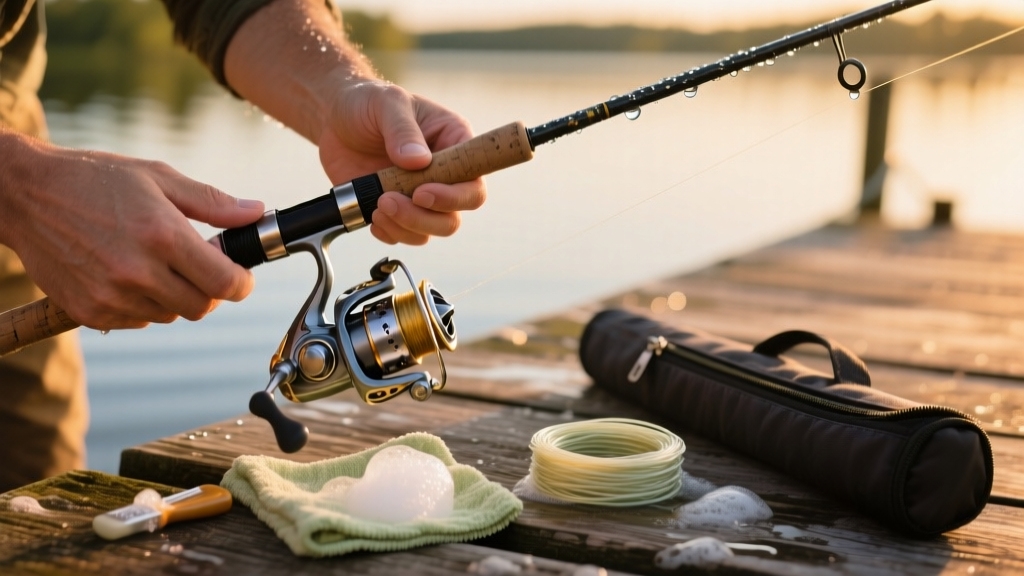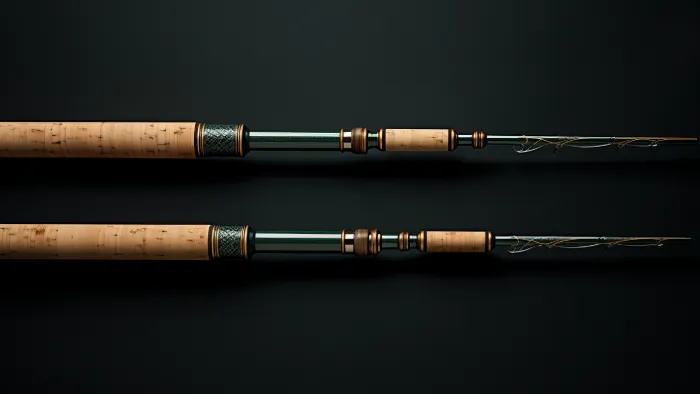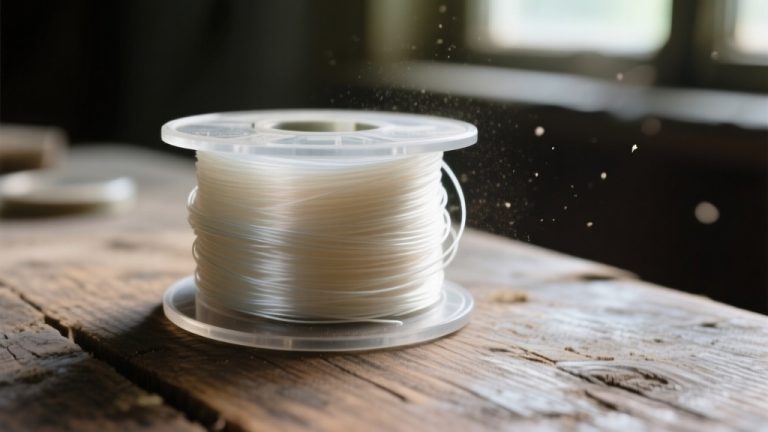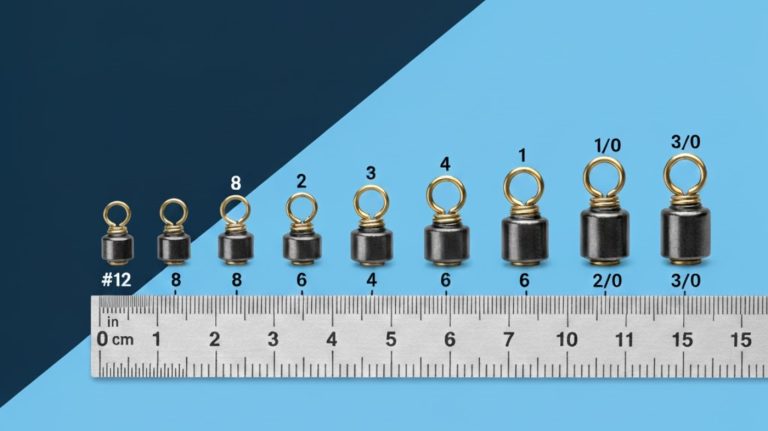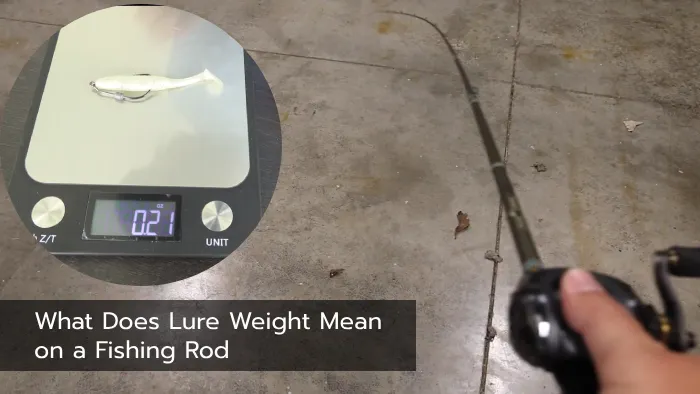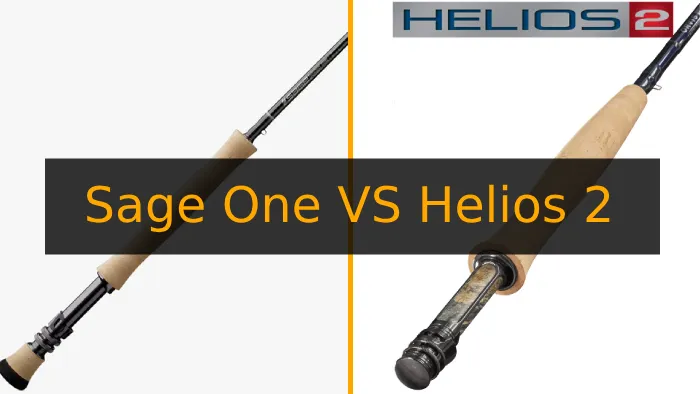How to Clean and Store Fishing Rods: Choose Trusted Brushes
To clean fishing rods, first remove the reel and line. Then rinse guides with warm, soapy water, using a soft brush or Q-tips to remove grime. Clean cork handles gently with a magic eraser or sponge, avoiding soaking. Inspect guides and reel seats for damage, tightening or replacing parts as needed.
Lightly lubricate reel bearings and hardware with reel-specific oil. Then store rods upright indoors, away from moisture and extreme temperatures. Want to make certain your gear stays in top condition all season long?
Key Takeaways
- Remove the reel and line before cleaning to avoid damage and ensure thorough cleaning of the rod and guides.
- Rinse guides with warm soapy water and scrub with a soft brush or Q-tips to remove grime and dirt.
- Clean cork handles gently with warm, soapy water and a magic eraser, avoiding soaking to protect glue joints.
- Store rods indoors in dry, ventilated spaces, keeping them upright or supported horizontally without bending.
- Use rod sleeves or socks for protection, remove reels before storage, and regularly inspect for moisture or damage.
Cleaning the Rod Guides
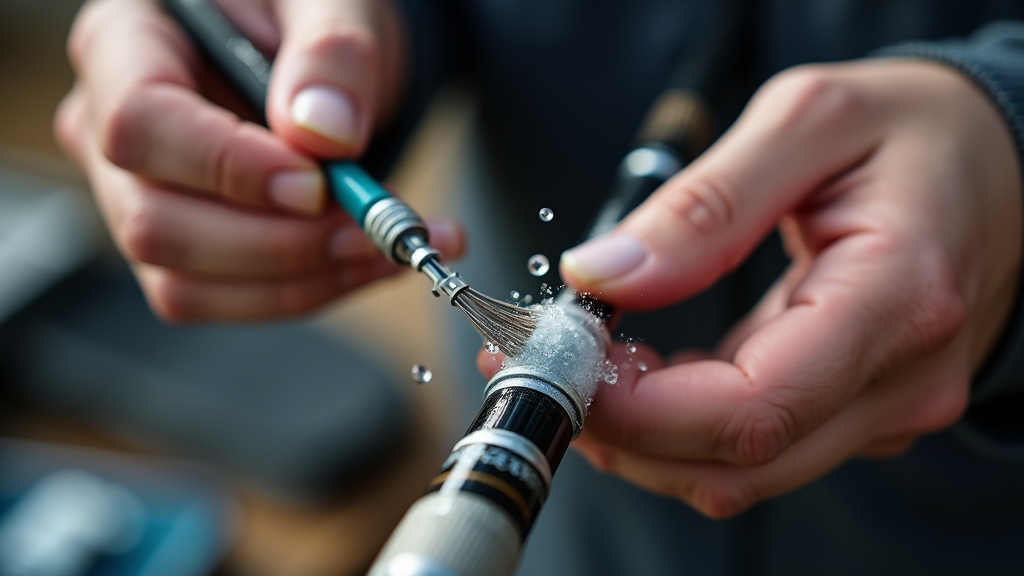
Although it might seem tedious, cleaning the rod guides is essential to maintain your fishing rod’s performance and longevity. Start by removing the fishing line and reel to avoid interference. Use warm fresh water mixed with mild dish soap to rinse and loosen grime.
Begin by detaching the line and reel, then rinse guides with warm water and mild soap to loosen dirt. Employ a soft-bristled brush or toothbrush to scrub inside and around each guide, focusing on edges where dirt accumulates.
For tight spaces, twist Q-tips inside the guides to dislodge stubborn deposits. If you fish saltwater, use a small wire brush carefully to remove corrosion. Using reels with enhanced corrosion resistance can also help reduce buildup on your guides.
Rinse all tools frequently to prevent redistributing salt or dirt. After cleaning, consider applying corrosion preventatives like WD-40 to protect guides. Clean rod handles with rubbing alcohol to maintain their appearance and grip, contributing to overall rod upkeep additional maintenance.
Cleaning the Rod and Reel
When you finish fishing, you should remove the reel from the rod before cleaning to prevent damage and guarantee thorough maintenance. Rinse the reel gently with fresh water, avoiding high-pressure sprays that can force debris inside.
Use a damp rag with mild soapy water or briefly submerge the reel to loosen grime, then rinse thoroughly. It is important to clean reels after each saltwater use to prevent corrosion and maintain longevity. Saltwater reel care
Dry the reel completely with a soft towel, shaking off trapped water. To avoid damaging delicate parts, be sure to use cold water rather than hot when rinsing. Loosen drag washers to prevent compression during storage.
Remove the spool to clean drag washers with a lubricant like WD-40, drying them before reassembly. After drying, lightly oil handles, bearings, and line rollers using an oiled rag to avoid moisture intrusion.
Inspecting and Repairing Rods
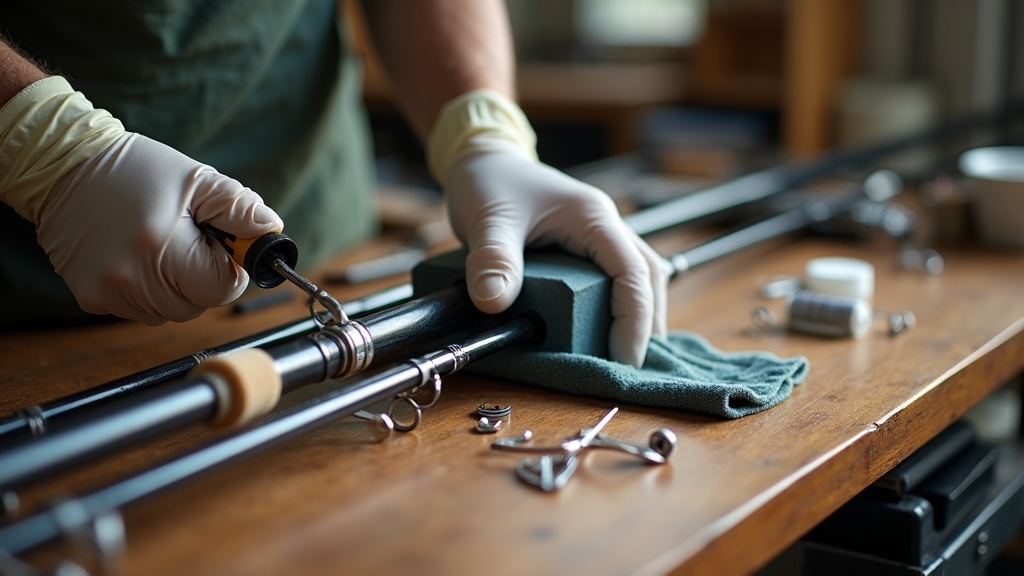
How do you guarantee your fishing rod stays reliable and performs at its best? Regularly inspecting and repairing key components is essential. Focus on these four critical areas:
- Ferrules: Check for cracks or chips and clean debris. Don’t force sections fully together; follow manufacturer specs for proper fit. Replace damaged ferrules to maintain strength.
- Guides: Feel for rough spots with a cotton swab. Replace cracked or worn guides to prevent line damage. Ensure guides align perfectly to avoid casting issues.
- Reel Seat: Examine for cracks and test locking rings for smooth operation. Replace any damaged parts to keep your reel secure.
- Rod Blank: Perform a load test by bending gently, listening for cracks or pops. Inspect for surface damage and repair or replace as needed to avoid failure.
Additionally, consider the type of fishing line or leader you plan to use, as fluorocarbon leader stiffness can affect sensitivity and control during your fishing activities.
Maintaining Rod Handles and Hardware
Hey there! To keep your rod handles in great shape, start by gently cleaning those cork handles. Just use some warm, soapy water—no harsh chemicals, please! They can really mess up the material. Also, using a tippet can help extend the life of your leader when fishing, reducing wear on your rod setup.
Also, don’t forget to regularly check the hardware. Make sure everything’s tight and give those moving parts a little lubrication now and then. It’ll help keep everything secure and working smoothly. After cleaning, be sure to allow cork handles to dry completely before applying any sealants or repairs to ensure the best results.
Cork Handle Cleaning
Although cork handles are prized for their comfort and grip, they require careful cleaning to maintain their texture and durability.
Start by gently scrubbing dirt with a moist sponge or mild dish soap applied by hand, avoiding harsh abrasives. For stubborn grime, use rubbing alcohol on a damp rag, testing a small area first. Choosing sunglasses with proper glare reduction can help protect your eyes while cleaning outdoors.
After cleaning, pat dry with a towel and let the cork air dry fully to prevent moisture damage. It is important to pat dry with a towel after cleaning to avoid trapping moisture in the cork.
Follow these steps for effective cork handle care:
- Use soft sponges or magic erasers dampened with water for gentle cleaning.
- Avoid soaking cork or aggressive scrubbing to preserve its structure.
- Protect adjacent rod parts with painter’s tape during cleaning.
- Apply cork sealers like U-40 after drying to extend handle life and repel dirt.
Hardware Tightness Checks
After maintaining your cork handle, turn your attention to the rod’s hardware and reel seat to guarantee everything stays securely attached and functions smoothly.
Regularly inspect metal components for looseness, corrosion, or wear. Tighten reel seats and handle hardware carefully by hand or with recommended tools, avoiding over-tightening that risks damage. It is important to check for damages regularly to address any issues before they worsen.
Check ferrules for snug fit, cleaning and lightly waxing them to ease assembly and prevent loosening. Examine guides and mounts for wobble or damaged wraps, repairing as needed to maintain casting accuracy.
Apply a light coat of corrosion-resistant lubricant on metal parts after cleaning, especially following saltwater use. Ensure locking rings turn smoothly and reel seats show no cracks. Dry hardware thoroughly before storage and store rods to prevent bending or impact damage, preserving hardware integrity over time.
Avoid Harsh Chemicals
When maintaining your fishing rod’s handles and hardware, steering clear of harsh chemicals is essential to preserve their durability and appearance. Strong solvents, acids, and bleach can degrade handle materials and bindings, shortening their lifespan.
Additionally, protecting your eyes from UV rays while fishing is important, as both UV protection and visual clarity contribute to a safer experience. Instead, follow these expert tips:
- Use mild dish soap with warm water and a soft brush or cloth for cleaning cork or synthetic handles. For tougher grime, gently using a Mr. Clean Magic Eraser dampened with water can effectively remove dirt without damaging the cork.
- Avoid soaking handles to prevent moisture damage to glue joints and hardware.
- Test any new cleaner on a small hidden area before full application to ensure compatibility.
- Clean metal hardware gently with mild soap and water, avoiding abrasive pads and harsh oils.
Lubrication and Reel Care
When it comes to taking care of your fishing reel, it’s super important to choose lubricants that are specifically designed for reels. This way, you can ensure that you’re getting the best protection and performance out of your gear.
After you’ve had a good fishing session, make sure to dry your reel thoroughly. Once it’s dry, you can apply oil sparingly to the key moving parts, like the line guide and handle shaft. This will help keep everything running smoothly and prevent any moisture buildup.
Always check if your reel has mag-sealed bearings before applying oil to avoid damage. Using lubrication compatible with fishing wader materials can also help maintain the reel’s longevity in wet environments.
Oh, and don’t forget to wipe away any excess oil after you’ve lubricated it! This little step goes a long way in ensuring your reel stays in top shape. Lastly, always store your reel in a dry, cool place. This helps maintain smooth operation and keeps corrosion at bay.
Choosing Proper Lubricants
Since the longevity and performance of your fishing reel depend heavily on proper lubrication, selecting the right lubricant is essential. You need to match lubricants to reel components for ideal function and protection.
Consider these key points:
- Use light synthetic oils for sleeve bearings and sliding parts. Mobil 1 is a reliable choice. Many experts recommend using synthetic oils because they offer better thermal stability and compatibility with reel materials.
- Apply grease with high oil content and water resistance for gears. NLGI 2 consistency suits most reels. Saltwater reels benefit particularly from corrosion-resistant greases to maintain durability.
- Choose marine-rated greases with corrosion inhibitors if you fish in saltwater.
- Avoid lubricants with solids like TFE or wax to prevent gumming and buildup over time.
Selecting advanced synthetic greases with corrosion protection and temperature stability will extend reel life and ensure smooth performance.
Applying Oil Correctly
Although oiling your fishing reel may seem straightforward, applying oil correctly demands precision to guarantee ideal performance and longevity. Start by cleaning all moving parts to remove dirt and salt. Apply a single drop of oil to pivot points on both sides of the bail arm, then work it back and forth to distribute lubricant.
Oil both sides of the line roller, ensuring bearings or sleeves move freely first. Remove the handle to access and oil interior bearings and the knob bearing for smooth rotation. It is important to consider your reel’s handle orientation for the best control and maintenance access.
After removing the spool, apply one drop to the main spindle and spin the handle to spread oil evenly. Lightly oil other moving joints, including pick-up pins and clutch screws, avoiding excess that attracts debris and impairs function.
Regular, sparing oiling maintains smooth, corrosion-free operation. For optimal reel longevity, it is important to apply oil & grease seasonally at the start and end of each fishing season.
Post-Lubrication Maintenance
Once you’ve properly lubricated your reel, maintaining its condition through regular post-lubrication care is vital to guarantee smooth operation and longevity.
You’ll want to follow these expert steps to keep your reel performing at its best:
- Wipe off any excess lubricant to prevent dirt buildup that can impair function. This helps avoid over-lubrication which can attract grime and cause malfunction.
- Gently rinse the reel with fresh water after use, avoiding high-pressure streams that force water into seals. This practice is essential to preserve the durability and overall performance of your reel.
- Thoroughly dry the reel with a microfiber towel to prevent corrosion and lubricant dilution.
- Loosen the drag after rinsing to avoid compression of drag washers, which leads to premature wear.
Proper Storage of Fishing Rods
When storing your fishing rods, selecting the right location is essential to maintaining their condition and longevity. Choose a dry, well-ventilated area indoors, like a garage or closet, avoiding damp sheds and extreme temperature changes.
Store rods upright or horizontally supported without bending to prevent warping. Use rod caddies, wall mounts, or DIY racks made from PVC and scrap wood to keep rods off the ground and organized.
Protect rods with rod socks or sleeves, and remove reels to prevent damage. Don’t jam rods tightly together; leave space to avoid pressure points and warping.
Regularly inspect stored rods for moisture or damage. Organize rods by type or frequency of use, and consider mobile racks for easy access and transport. In saltwater environments, ensure rods are elevated with good airflow to help prevent corrosion.
Preventing Line Abrasion Through Guide Maintenance
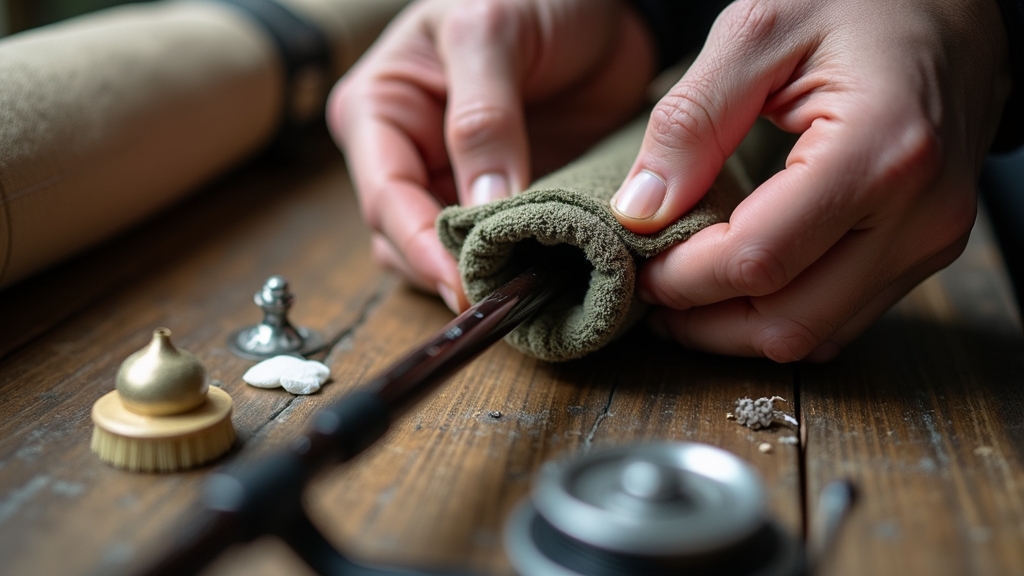
Regularly inspecting and maintaining your fishing rod guides is essential to preventing line abrasion and ensuring smooth casting performance. Damaged or dirty guides cause friction points that fray or break your line, risking lost catches.
Here’s how to keep them in top shape:
- Inspect frequently: Check for cracks, chips, or wear before and after each trip to catch damage early.
- Clean thoroughly: Use a Q-tip or soft brush with mild soap or Simple Green, cleaning inside and outside the guides to remove minerals and debris.
- Avoid abrasives: Never use wire brushes or harsh chemicals that can scratch or corrode guides.
- Protect from corrosion: Rinse guides after saltwater exposure, dry completely, and apply a light coating of WD-40 to prevent rust and pitting.
Following these steps extends guide life and preserves your line’s integrity.
Seasonal Maintenance Tips for Fishing Gear
Although fishing gear often withstands tough conditions, seasonal maintenance is essential to keep your equipment performing reliably. Start by cleaning rods and handles using mild soap and water. Then inspect them closely for cracks or fatigue.
Check eyelets for alignment and clean them to guarantee smooth line flow. Replace damaged parts promptly. Next, examine fishing lines for wear and replace them early in the season, following manufacturer guidelines.
Organize your tackle box by discarding broken lures and sharpening hooks. Consider reorganizing for better efficiency and relocating frequently used items to accessible spots. Store all gear in a temperature-controlled, dry environment to prevent rust and warping.
Finally, test electronic devices and safety equipment, replace batteries, and verify permits. These steps will extend your gear’s lifespan and ensure a smooth, safe fishing season.
Frequently Asked Questions
How Often Should I Replace My Fishing Line for Best Performance?
You should replace your fishing line based on type and usage. Monofilament and fluorocarbon lines need changing every 6 to 12 months, especially if exposed to sunlight or saltwater.
Braided lines last longer but inspect them regularly for fraying or thin spots and replace annually or sooner if damaged. Always check for abrasions, kinks, or loss of strength. Frequent anglers may need to replace lines more often to maintain peak performance.
Can I Use Household Oils Instead of Reel-Specific Lubricants?
You shouldn’t use household oils instead of reel-specific lubricants. Household oils often contain additives that gum up your reel’s mechanisms and don’t protect against corrosion or wear like synthetic reel oils do.
Stick to specialized reel oils and greases designed for bearings and gears. They guarantee smooth operation and longer reel life. Apply sparingly, as over-lubrication can cause buildup and attract dirt, ultimately harming your reel’s performance.
What Are the Best Materials for Fishing Rod Handles?
You might think foam handles are best due to their lightness, but cork actually offers superior grip and comfort, especially when wet. If sensitivity matters, carbon fiber or synthetic composites excel by transmitting vibrations efficiently, though they can feel hard without padding.
For durability and aesthetics, cork’s your go-to; EVA foam suits budget needs, and wood offers unique style but requires more care. Match material choice to your fishing style and comfort preferences.
How Do I Transport Fishing Rods Safely on a Boat or Vehicle?
To transport fishing rods safely on a boat or vehicle, secure them using rod racks or dedicated carriers to prevent shifting. Tie rods between seats with a tension device or rest them on stable surfaces with heels supported.
Use protective sleeves or soft tubes on rods and store reels separately. Avoid rigging rods with heavy lures during transit and always inspect for damage beforehand. Position rod tips backward if mounted externally to minimize stress.
Are There Specific Cleaning Products to Avoid on Fishing Gear?
Yes, you should avoid cleaners containing phosphorus, nitrogen, ammonia, bleach, or harsh solvents on fishing gear. Stay away from abrasive products, household detergents, and unverified “natural” cleaners that might damage finishes or internal reel parts.
Instead, use mild, fishing-specific cleaners with corrosion inhibitors. Rinse regularly with freshwater to minimize buildup and protect your rods and reels, ensuring they stay in top condition without harming the environment.
Protect Your Investment: Store Rods Safely with Smart Storage Solutions
By following these expert tips, you’ll keep your fishing rods in pristine condition, ready to perform like new every time you cast. Neglecting proper cleaning and storage is like tossing your gear into a black hole; lost and broken beyond repair.
Regularly clean guides, handles, and reels, inspect for damage, and store rods properly to extend their lifespan. With just a little care, your fishing rods will serve you faithfully season after season.

